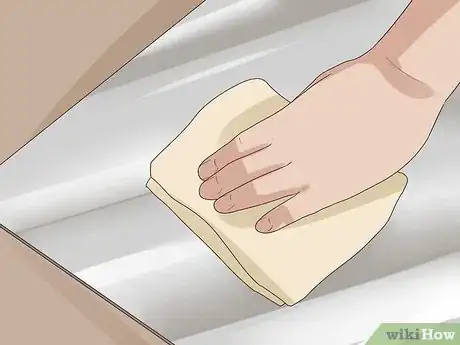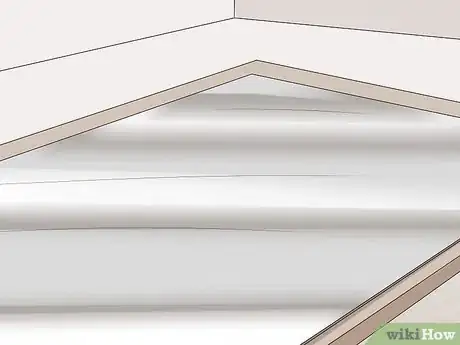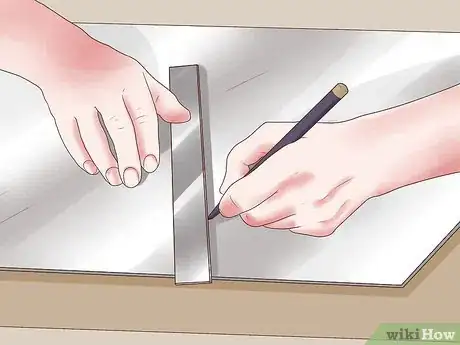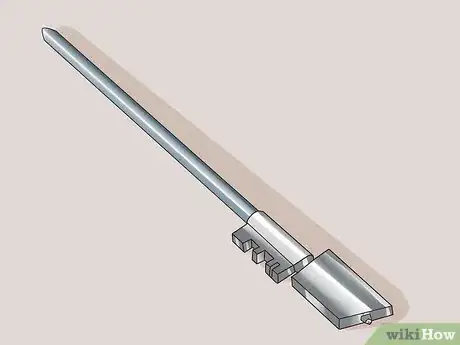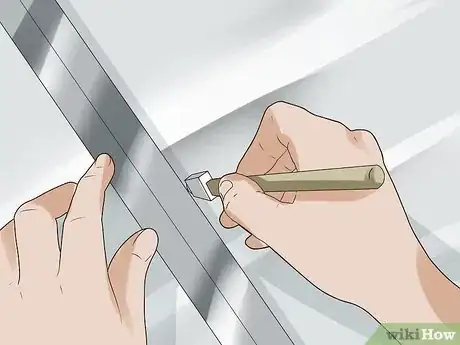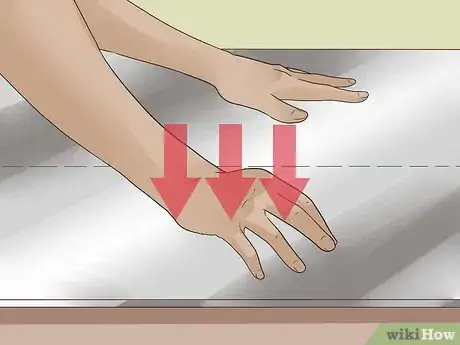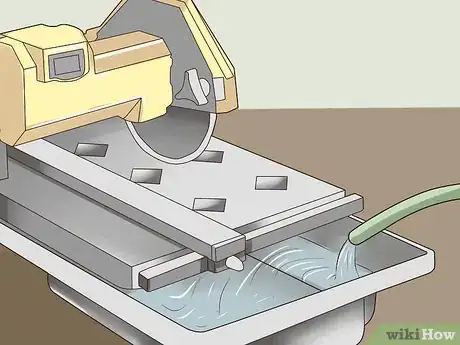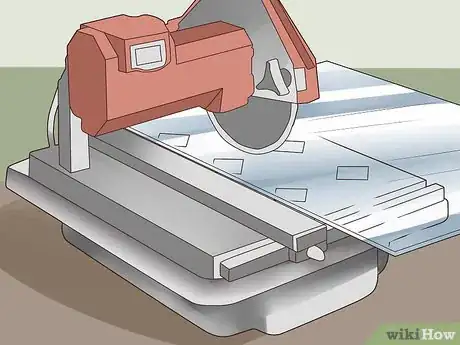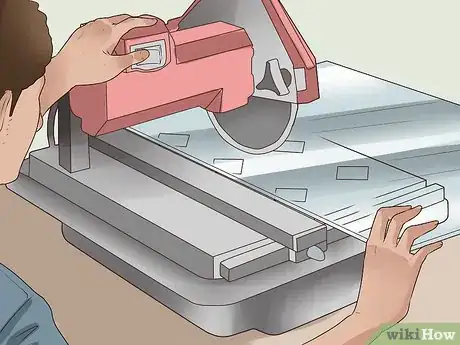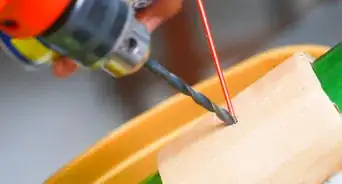This article was co-authored by wikiHow staff writer, Amber Crain. Amber Crain has been a member of wikiHow’s writing staff for the last six years. She graduated from the University of Houston where she majored in Classical Studies and minored in Painting. Before coming to wikiHow, she worked in a variety of industries including marketing, education, and music journalism. She's been a radio DJ for 10+ years and currently DJs a biweekly music program on the award-winning internet radio station DKFM. Her work at wikiHow supports her lifelong passion for learning and her belief that knowledge belongs to anyone who desires to seek it.
This article has been viewed 113,894 times.
Learn more...
Home projects, like window repairs, often require the cutting of thick glass. While you can pay a professional to cut the glass for you, doing it yourself is much more cost effective. The most efficient technique, especially if you don’t have a home shop, is using a handheld glass cutter with a carbide wheel to score and then cleanly break the glass. If you want a little more power and prefer to avoid the scoring/breaking process, opt for a wet saw.
Steps
Organizing the Project
-
1Clean the glass thoroughly with a microfiber cloth. It’s crucial that the area where you plan to cut is thoroughly cleaned before you begin. Even tiny dust particles can interrupt the cut and lead to uncontrolled breakage. Wipe the glass down using a quality glass cleaner or rubbing alcohol.[1] Use a microfiber cloth – the tiny fibers can clean even microscopic dirt particles.
- Avoid using cotton or nylon cloths on the glass, since these can leave behind large fibers and dust.
- Use a clean, dry microfiber cloth to go over the surface once more before you begin. Make surface must be completely dry.
-
2Wear protective attire. During the cutting process, tiny glass shards will be flying through the air at very high speeds. These could potentially get in your eyes or cut your skin. Safety goggles, heavy-duty work gloves and a long-sleeved shirt will protect you. Make sure they are of a high quality. Do not rub your face or eyes while you’re working with glass.
- Avoid wearing open-toed shoes and sandals during this project.
- Never handle freshly cut glass unless you’re wearing thick gloves. The edges will be extremely sharp.[2]
Advertisement -
3Prepare the workspace. You will need to cut thick glass on a hard, flat surface that is completely free of debris. The work surface needs to be sturdy and, if possible, covered in felt or some other type of soft material. When you start cutting the glass, a great deal of tension will be created – the soft surface will allow the glass to withstand it.
- If you don’t have a felted tabletop, cover the work surface with a piece of cardboard. Duct tape it firmly in place.
- Keep a small broom and trash can nearby. Cutting will generate glass chips, which can interrupt the accuracy of your cut and damage your tools. You will need to stop periodically during the process to brush them away.[3]
Scoring and Breaking the Glass
-
1Use a straight edge and grease pencil to mark your cut lines. A clean, successful break depends on precise measurements and accurate cut lines. Use a straight edge to designate where you want the glass to be cut. Use a grease pencil or sharpie to draw the lines on the glass where you want to cut it. The cut lines will be your guide for scoring.
- You will use a glass scoring tool to “trace” over the cut lines.
- Be sure to your cut lines start at one edge of the glass and end at the another.[4]
-
2Select a carbide wheel glass cutter to score the surface. A glass cutter, also known as a scoring tool, does not break the glass. Instead, it scratches a line into the surface of the glass, weakening it. Once the glass is scored, you can then break it cleanly along the score line. When cutting thick glass, make sure you use a cutter that has a carbide wheel tip.
- Steel-wheeled cutters tend to be flimsy in comparison and require lubrication.[5]
- You can buy glass cutters at any hardware store.
-
3Use one long, continuous motion to score each line. Grip the handle of the scoring tool firmly and vertically in your hand and place the wheel at the beginning of your first cut line. Line the straight edge up right next to the line for extra support. Using light pressure, run the tool along the line, right next to the straight edge. Make sure you apply equal pressure from the beginning to the end of each score line. Use one even, continuous motion.[6]
- You will hear a clicking sound as the glass is scored.[7] If you don’t hear it, press down a little harder.
-
4Apply pressure to break the glass along the score lines. Place the scored glass on the edge of a hard surface, such as your work station, making sure that the scored edge of the glass is directly aligned with the edge of the counter. Push down quickly on the part of the glass which is hanging off the work station. It should snap off easily and cleanly in your hands. To make a clean break along curved score lines, its best to use a pair of running pliers.
Using a Wet Saw
-
1Rent or buy a wet saw at a hardware store. A wet saw is a motorized saw with a diamond blade that is used to cut tile, glass, porcelain, and other delicate products. During operation, water is sprayed out of the front of the saw to ensure that the blade stays cool and lubricated. Wet saws cut through thick glass very easily. They are a great choice if you plan to cut glass frequently or if you want to avoid the scoring and breaking process.
- You must wear safety goggles and heavy-duty work gloves when operating a wet saw. Do not allow anyone in the work area unless they are wearing safety goggles and protective clothing.
-
2Fill the saw’s tray with water. Using a power saw to cut into thick glass is very dangerous without the aid of water, because the glass can get extremely hot and eventually explode. Fill up the saw’s tray completely with water and inspect the saw to make sure nothing is blocking the water flow from the reservoir. Adequate water flow must be maintained during the operation of a wet saw.
-
3Line the wet saw up with your first cut line. Precise measurements and accurate cut lines are important no matter which cutting technique you employ. After measuring and drawing your cut lines on the surface of the glass with a straight edge and a sharpie, carefully line up the saw’s blade with your first cut line. Make sure that your hands and clothing are well out of the way of the blade before you turn it on.
-
4Turn on the wet saw and cut the glass. Using light pressure, gently push the glass towards the wet saw. Do not push the blade into the glass, as this will result in a messy cut. Push the glass slowly, lightly and steadily against the blade. Continue until the blade has cut the glass along the entirety of the cut line you drew on the glass.
- Move onto the next cut line and continue.
- Turn off the wet saw when you’ve finished with the job and empty the water from the saw’s tray.
Community Q&A
-
QuestionHow do I cut a curved line on glass with my wet saw?
 Community AnswerIf you're cutting a lot of curved lines, you may find that scoring and breaking the glass is a better method. To use the wet saw, you'll need to go very slowly and carefully to get a clean curve. Push the glass into the blade, not the other way around. Make sure adequate water flow is maintained.
Community AnswerIf you're cutting a lot of curved lines, you may find that scoring and breaking the glass is a better method. To use the wet saw, you'll need to go very slowly and carefully to get a clean curve. Push the glass into the blade, not the other way around. Make sure adequate water flow is maintained.
References
- ↑ http://www.viewalongtheway.com/2012/10/how-to-cut-mirror-or-glass/
- ↑ http://www.clearwaterglass.com/Tutorials/CuttingGlass.html
- ↑ http://www.clearwaterglass.com/Tutorials/CuttingGlass.html
- ↑ http://www.clearwaterglass.com/Tutorials/CuttingGlass.html
- ↑ https://www.youtube.com/watch?v=LH3rgoBaYlA
- ↑ http://www.clearwaterglass.com/Tutorials/CuttingGlass.html
- ↑ http://www.motherearthnews.com/diy/how-to-cut-glass-zmaz76mazhar?pageid=3#PageContent3
About This Article
To cut thick glass, start by using a straight edge and grease pencil to mark your cut lines on the surface. Next, use a carbide wheel glass cutter to score along the lines using one long, continuous motion for each line. Then, place the scored glass on the edge of a hard surface and apply pressure to break the glass along the line. If your glass is too big or cumbersome to score and break, you can rent a wet saw and use that to cut along the lines instead. For more tips on operating a wet saw, read on!
